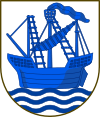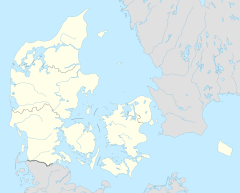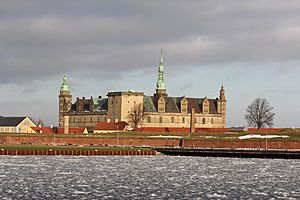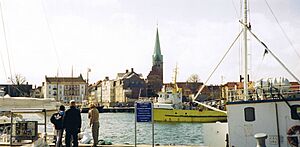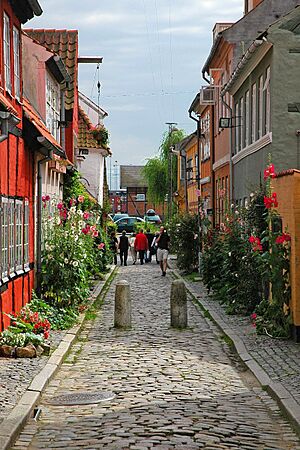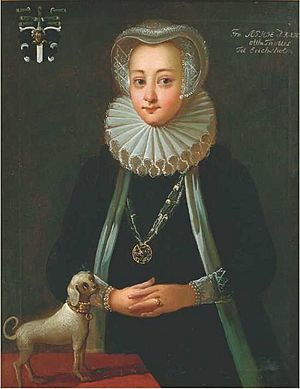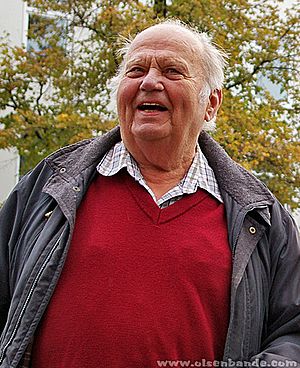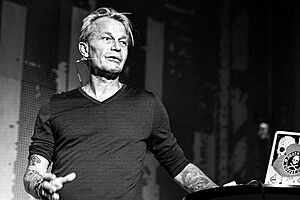Helsingør facts for kids
Quick facts for kids
Helsingør
Elsinore
|
||
|---|---|---|
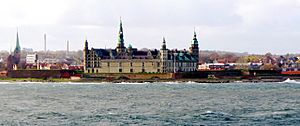
Helsingør waterfront in November 2006, with Kronborg Castle
|
||
|
||
| Country | Denmark | |
| Region | Capital (Hovedstaden) | |
| Municipality | Helsingør | |
| Established | 1420s | |
| City charter | 1426 | |
| Current municipality | 2007-01-01 | |
| Area | ||
| • Urban | 17.9 km2 (6.9 sq mi) | |
| Elevation | 8 m (26 ft) | |
| Population
(2024)
|
||
| • Urban | 47,945 | |
| • Urban density | 2,639/km2 (6,830/sq mi) | |
| • Gender | 23,015 males and 24,930 females | |
| Demonym(s) | Helsingoraner | |
| Time zone | UTC+1 (CET) | |
| • Summer (DST) | UTC+2 (CEST) | |
| Postal code |
3000
|
|
| Area code(s) | (+45) 49 | |
Helsingør is a city on the coast in northeastern Denmark. It is also known as Elsinore in English. The city is located at the narrowest part of the Øresund strait. This is a narrow stretch of water between Denmark and Sweden.
Helsingør and Helsingborg in Sweden are like twin cities across the strait. They form the northern part of the Øresund Region. This region is centered around Copenhagen in Denmark and Malmö in Sweden. Helsingør is a busy ferry city. Many ferries travel between Helsingør and Helsingborg, which is about 4 kilometers (2.5 miles) away.
One of the most famous landmarks in Helsingør is Kronborg Castle. This castle was used by William Shakespeare as the setting for his famous play, Hamlet.
Contents
What's in a Name? The Meaning of Helsingør
The name Helsingør has an interesting history. The first part, Hels, likely comes from the Old Norse word hals. This word means 'neck' or 'narrow strait'. It refers to the narrowest point of the Øresund strait.
The word Helsing probably means 'people who live by the neck' (the strait). The ending ør comes from an old Norse word meaning 'gravel beach' or 'sandy shore'.
The city was first mentioned as Hælsingør in 1231. The people living there were called Helsinger. Some believe the Helsinger people might have had their main fort in Helsingborg. They also had a landing place in Helsingør to control the ferry route.
A Look Back: The History of Helsingør
The city we know today was started in the 1420s by Eric of Pomerania, a Danish King. He introduced the Sound Dues in 1429. This was a toll, or fee, that ships had to pay to use the Øresund strait.
The Sound Dues were paid in Helsingør. This brought a lot of money and wealth to the city. With this money, the king built a castle called Krogen. It was located at the very tip of the island of Zealand. The city grew around this castle.
In the 1570s, King Frederik II rebuilt and expanded Krogen. He renamed it Kronborg. All ships had to stop in Helsingør to pay their taxes and tolls to the Danish Crown. This created a lot of trade for the city. By 1672, Helsingør was the third-largest town in Denmark. It remained one of the biggest cities until the mid-1800s.
The Sound Dues were stopped in 1857. This happened with the Copenhagen Convention of 1857. All seafaring nations agreed to pay a one-time fee instead. Stopping the tolls was a big loss for Helsingør. The city's population grew slowly in the decades that followed.
The oldest known fortified building in Helsingør is Flynderborg. This was an early medieval fortress on a hill south of the old city. Around 1200, the first church, Saint Olaf's Church, was built. Today, it is the cathedral of the Diocese of Helsingør. Its oldest parts show that Helsingør was already an important town back in the 13th century.
Helsingør's Role in World War II
During World War II, Helsingør played a very important role. It was a key point for helping Denmark's Jewish population escape during the Holocaust. In October 1943, Adolf Hitler ordered that all Danish Jews be arrested and sent to concentration camps.
Georg Ferdinand Duckwitz, a German diplomat, secretly shared this information. The Danish people quickly formed a network to help. They used the name "Elsinore Sewing Club" as a secret code. They moved Jews away from the closely watched docks in Copenhagen. Many were brought to Helsingør.
Helsingør was ideal because it was only two miles across the Øresund to Helsingborg in neutral Sweden. Hundreds of Danish citizens hid their Jewish neighbors in their homes, farms, and churches. They then helped them board fishing boats, private boats, and ferries. Over three nights, Danes helped over 7,200 Jews and 680 non-Jews escape to safety in Sweden.
Getting Around: Transport in Helsingør
The car ferry line between Helsingør and Helsingborg in Sweden is one of the busiest in the world. There are more than 70 departures in each direction every day. This route is known as the HH Ferry route.
The Helsingør ferry terminal is connected to the city's main railway station. From this station, trains go to Copenhagen every 20 minutes. Trains also travel to Hillerød and Gilleleje. There are six other train stations or stops within the city and its suburbs.
The E47 motorway towards Copenhagen starts just outside Helsingør. The city also has a network of local and regional buses.
From Industry to Culture: Helsingør's Transformation
For about a century, the Helsingør shipyard was a major landmark. It was founded in 1882 and covered a large area between the town and Kronborg Castle. At its busiest in 1957, it had 3,600 employees. The shipyard closed in 1983.
After the industrial era ended, Helsingør had to find new ways to grow. The city created an exciting project called Kulturhavn Kronborg, or "Culture-harbour of Kronborg." It opened in May 2013. This project aims to attract tourists interested in culture.
The main attraction of Kulturhavn Kronborg is Kronborg Castle, which is a UNESCO World Heritage Site. Since 1937, William Shakespeare's play Hamlet has been performed in the castle courtyard every year. Famous actors like Laurence Olivier and Jude Law have played Hamlet there.
At the heart of Kulturhavn Kronborg is kulturværftet, or The Culture Yard. This is a new cultural center and public library. It is located in the old shipyard. The former dry dock now houses the Danish Maritime Museum.
In the middle of the harbor basin, there is a shiny steel sculpture called Han (He). It was created by the artists Elmgreen and Dragset in 2012. This sculpture is seen as a modern version of The Little Mermaid statue in Copenhagen.
Famous People from Helsingør
Many notable people have connections to Helsingør:
Public Service
- Christiern Pedersen (c.1480–1554) – A scholar and publisher.
- Christian de Meza (1792–1865) – A general who led the Danish Army.
- Olivia Nielsen (1852–1910) – A Danish trade union leader and politician.
- Morten Løkkegaard (born 1964) – A Danish politician and Member of the European Parliament.
Arts
- Pieter Isaacsz (1569–1625) – A Danish-born Dutch painter.
- Anton Melbye (1818–1875) – A Danish marine artist.
- Peter Elfelt (1866–1931) – A photographer and early cinema pioneer.
- Ove Verner Hansen (1932–2016) – A Danish opera singer and actor.
- Helle Fagralid (born 1976) – A Danish actress.
Science and Business
- Sophia Brahe (1559–1643) – A noblewoman with knowledge of astronomy and chemistry.
- Stephen Hansen (1701–1770) – An industrialist and businessman.
- Ludvig Lorenz (1829–1891) – A physicist and mathematician.
- Wilhelm Johannsen (1857–1927) – A Danish botanist and geneticist.
- Mette Blomsterberg (born 1970) – A Danish pastry chef and cookbook writer.
Sports
- Edgar Aabye (1865–1941) – An athlete who won a gold medal in tug of war at the 1900 Summer Olympics.
- Willy Hansen (1906–1978) – A Danish track cyclist and Olympic medalist.
- Mikkel Hansen (born 1987) – A world-famous handball player.
Areas of Helsingør: Districts and Neighborhoods
Helsingør is divided into several areas:
- Centrum: The city center.
- North: Includes Grønnehave, Højstrup, Marienlyst, Hellebæk, Ålsgårde, and Hornbæk.
- West: Includes Sundparken, Grøningen, Nøjsomheden, Vapnagård, Gurre, Nygård, and Tikøb.
- South: Includes Skotterup, Snekkersten, and Espergærde.
Sister Cities
Helsingør has "sister city" relationships with other towns. This means they share cultural and educational ties. You can find a list of these cities in the article about Helsingør Municipality.
Images for kids
See also
 In Spanish: Elsinor para niños
In Spanish: Elsinor para niños


